How Does Land Urbanization Affect Carbon Emissions in China? Evidence from 209 Cities and Three Heterogeneous Regions in the East of the Hu Line of China
Abstract
1. Introduction
2. Analysis Framework
2.1. Direct Effect
2.2. Indirect Spillover Effect
3. Materials and Methods
3.1. Study Areas Selection
3.2. Model Methods
3.2.1. STIRPAT Model
3.2.2. Spatial Autocorrelation
3.2.3. Bivariate Spatial Autocorrelation
3.2.4. Spatial Econometric Model
3.3. Data Source and Processing
4. Results
4.1. Spatial and Temporal Changes of LU and CEs
4.1.1. Spatial and Temporal Changes of LU
4.1.2. Spatial and Temporal Changes of CEs
4.2. Empirical Results and Analysis
4.2.1. Spatial Autocorrelation Analysis
4.2.2. LISA Cluster Analysis
4.2.3. Empirical Analysis of the Impact of LU on CEs
4.2.4. Regional Heterogeneity Analysis of LU on CEs
5. Discussion
5.1. Summary of Findings
5.2. Limitation and Future Outlook
5.3. Policy Suggestions
6. Conclusions
Author Contributions
Funding
Data Availability Statement
Conflicts of Interest
Appendix A
| Variables | Model I W1 | ||
|---|---|---|---|
| Direct Effect | Indirect Effect | Total Effect | |
| lnLU | 0.336 *** | 0.174 *** | 0.510 *** |
| (0.047) | (0.063) | (0.043) | |
| lnGDP | 0.125 | −0.181 | −0.056 |
| (0.087) | (0.122) | (0.110) | |
| lnPTI | −0.169 | 0.187 | 0.017 |
| (0.116) | (0.165) | (0.103) | |
| lnP | 0.576 *** | −0.259 *** | 0.317 *** |
| (0.068) | (0.089) | (0.076) | |
| Variables | Model I W1 | ||
|---|---|---|---|
| Direct Effect | Indirect Effect | Total Effect | |
| lnLU | 0.304 | 3.080 | 3.384 |
| (0.103) | (0.399) | (0.475) | |
| lnGDP | 0.403 ** | −2.190 *** | −1.787 *** |
| (0.174) | (0.387) | (0.462) | |
| lnPTI | −0.489 *** | −2.509 *** | −2.998 *** |
| (0.157) | (0.433) | (0.553) | |
| lnP | 1.807 *** | 1.241 ** | 3.048 *** |
| (0.271) | (0.600) | (0.853) | |
| Variables | Model I W1 | ||
|---|---|---|---|
| Direct Effect | Indirect Effect | Total Effect | |
| lnLU | 0.177 *** | 0.067 | 0.244 *** |
| (0.033) | (0.053) | (0.038) | |
| lnGDP | 0.817 *** | −0.181 * | 0.636 *** |
| (0.066) | (0.099) | (0.068) | |
| lnPTI | −0.361 *** | 0.235 * | −0.126 |
| (0.095) | (0.134) | (0.104) | |
| lnP | 0.650 *** | 0.031 | 0.681 *** |
| (0.044) | (0.068) | (0.075) | |
References
- Zhang, S.; Li, Z.; Ning, X.; Li, L. Gauging the impacts of urbanization on CO2 emissions from the construction industry: Evidence from China. J. Environ. Manag. 2021, 288, 112440. [Google Scholar] [CrossRef] [PubMed]
- Kahn, M.E.; Mohaddes, K.; Ng, R.N.C.; Pesaran, M.H.; Raissi, M.; Yang, J.-C. Long-term macroeconomic effects of climate change: A cross-country analysis. Energy Econ. 2021, 104, 105624. [Google Scholar] [CrossRef]
- Auffhammer, M.; Carson, R.T. Forecasting the path of China’s CO2 emissions using province-level information. J. Environ. Econ. Manag. 2008, 55, 229–247. [Google Scholar] [CrossRef]
- Fan, M.; He, G.; Zhou, M. The winter choke: Coal-Fired heating, air pollution, and mortality in China. J. Health Econ. 2020, 71, 102316. [Google Scholar] [CrossRef]
- Wang, S.; Fang, C.; Guan, X.; Pang, B.; Ma, H. Urbanisation, energy consumption, and carbon dioxide emissions in China: A panel data analysis of China’s provinces. Appl. Energy 2014, 136, 738–749. [Google Scholar] [CrossRef]
- Li, Z.-Z.; Li, R.Y.M.; Malik, M.Y.; Murshed, M.; Khan, Z.; Umar, M. Determinants of Carbon Emission in China: How Good is Green Investment? Sustain. Prod. Consum. 2021, 27, 392–401. [Google Scholar] [CrossRef]
- Tan, X.; Dong, L.; Chen, D.; Gu, B.; Zeng, Y. China’s regional CO2 emissions reduction potential: A study of Chongqing city. Appl. Energy 2016, 162, 1345–1354. [Google Scholar] [CrossRef]
- Zhao, J.; Jiang, Q.; Dong, X.; Dong, K. Assessing energy poverty and its effect on CO2 emissions: The case of China. Energy Econ. 2021, 97, 105191. [Google Scholar] [CrossRef]
- Yang, S.; Yang, X.; Gao, X.; Zhang, J. Spatial and temporal distribution characteristics of carbon emissions and their drivers in shrinking cities in China: Empirical evidence based on the NPP/VIIRS nighttime lighting index. J. Environ. Manag. 2022, 322, 116082. [Google Scholar] [CrossRef]
- Gu, H.; Ma, T.; Qian, F.; Cai, Y. County land use scenario simulation and carbon emission effect analysis using CLUE-S model. Trans. CSAE 2022, 38, 288–296. [Google Scholar] [CrossRef]
- Wei, M.; Cai, Z.; Song, Y.; Xu, J.; Lu, M. Spatiotemporal evolutionary characteristics and driving forces of carbon emissions in three Chinese urban agglomerations. Sustain. Cities Soc. 2024, 104, 105320. [Google Scholar] [CrossRef]
- Bahrami, S.; Amini, M.H. A Decentralized Trading Algorithm for an Electricity Market with Generation Uncertainty. Appl. Energy 2017, 218, 520–532. [Google Scholar] [CrossRef]
- Du, L.; Hanley, A.; Zhang, N. Environmental technical efficiency, technology gap and shadow price of coal-fuelled power plants in China: A parametric meta-frontier analysis. Resour. Energy Econ. 2016, 43, 14–32. [Google Scholar] [CrossRef]
- Zhou, Y.; Chen, M.; Tang, Z.; Mei, Z. Urbanization, land use change, and carbon emissions: Quantitative assessments for city-level carbon emissions in Beijing-Tianjin-Hebei region. Sustain. Cities Soc. 2021, 66, 102701. [Google Scholar] [CrossRef]
- Farinmade, A.; Soyinka, O.; Siu, K.W.M. Assessing the effect of urban informal economic activity on the quality of the built environment for sustainable urban development in Lagos, Nigeria. Sustain. Cities Soc. 2018, 41, 13–21. [Google Scholar] [CrossRef]
- Li, J.; Huang, X.; Chuai, X.; Yang, H. The impact of land urbanization on carbon dioxide emissions in the Yangtze River Delta, China: A multiscale perspective. Cities 2021, 116, 103275. [Google Scholar] [CrossRef]
- Tang, M.; Hu, F. How Does Land Urbanization Promote CO2 Emissions Reduction? Evidence From Chinese Prefectural-Level Cities. Front. Environ. Sci. 2021, 9, 766839. [Google Scholar] [CrossRef]
- Zhang, C.; Lin, Y. Panel estimation for urbanization, energy consumption and CO2 emissions: A regional analysis in China. Energy Policy 2012, 49, 488–498. [Google Scholar] [CrossRef]
- Guo, S.; Zhang, Y.; Qian, X.; Ming, Z.; Nie, R. Urbanization and CO2 emissions in resource-exhausted cities: Evidence from Xuzhou city, China. Nat. Hazards 2019, 99, 807–826. [Google Scholar] [CrossRef]
- Song, S. Analysis of the Impact of Urbanization on Carbon Emissions in China Based on Threshold Model. Master’s Thesis, Beijing Jiaotong University, Beijing, China, 2021. [Google Scholar] [CrossRef]
- Shi, K.; Chen, Y.; Li, L.; Huang, C. Spatiotemporal variations of urban CO2 emissions in China: A multiscale perspective. Appl. Energy 2018, 211, 218–229. [Google Scholar] [CrossRef]
- York, R. Demographic trends and energy consumption in European Union Nations, 1960–2025. Soc. Sci. Res. 2007, 36, 855–872. [Google Scholar] [CrossRef]
- Zeng, D.; Wang, X. Comparative Study of Relationship between Carbon Emission and Medium-term Urbanization in Different Countries. J. Chongqing Univ. (Soc. Sci. Ed.) 2015, 21, 46–50. [Google Scholar] [CrossRef]
- Sharma, S.S. Determinants of carbon dioxide emissions: Empirical evidence from 69 countries. Appl. Energy 2011, 88, 376–382. [Google Scholar] [CrossRef]
- Xu, L. Research on the Dynamic Influence Relationship of Urbanization on Carbon Emission. Sci. Technol. Manag. Res. 2014, 34, 226–230. [Google Scholar] [CrossRef]
- Zhao, H.; Chen, Y. Research on Relationship Between Urbanization Process and Carbon Emission Reduction in China. China Soft Sci. 2013, 3, 184–192. [Google Scholar]
- Gökmenoğlu, K.; Taspinar, N. The relationship between CO2 emissions, energy consumption, economic growth and FDI: The case of Turkey. J. Int. Trade Econ. Dev. 2016, 25, 706–723. [Google Scholar] [CrossRef]
- Tiba, S. A non-linear assessment of the urbanization and climate change nexus: The African context. Environ. Sci. Pollut. Res. 2019, 26, 32311–32321. [Google Scholar] [CrossRef]
- Xu, B.; Lin, B. How industrialization and urbanization process impacts on CO2 emissions in China: Evidence from nonparametric additive regression models. Energy Econ. 2015, 48, 188–202. [Google Scholar] [CrossRef]
- Zhang, Y.; Liu, Z.; Zhang, H.; Tan, T. The impact of economic growth, industrial structure and urbanization on carbon emission intensity in China. Nat. Hazards 2014, 73, 579–595. [Google Scholar] [CrossRef]
- Li, K.; Lin, B. Impacts of urbanization and industrialization on energy consumption/CO2 emissions: Does the level of development matter? Renew. Sustain. Energy. Rev. 2015, 52, 1107–1122. [Google Scholar] [CrossRef]
- Xu, Q.; Dong, Y.; Yang, R. Urbanization impact on carbon emissions in the Pearl River Delta region: Kuznets curve relationships. J. Clean. Prod. 2018, 180, 514–523. [Google Scholar] [CrossRef]
- Normile, D. China’s Living Laboratory in Urbanization. Science 2008, 319, 740–743. [Google Scholar] [CrossRef] [PubMed]
- Li, Z.; Wang, J.; Che, S. Effects of Land Urbanization on Spatial Emission Reduction: Internal Mechanism and China Experience. Stat. Res. 2021, 38, 89–104. [Google Scholar] [CrossRef]
- Liu, J.; Zhang, Q.; Hu, Y. Regional differences of China’s urban expansion from late 20th to early 21st century based on remote sensing information. Chin. Geogr. Sci. 2012, 22, 1–14. [Google Scholar] [CrossRef]
- Tang, M.; Hu, F. Land urbanization and urban CO2 emissions: Empirical evidence from Chinese prefecture-level cities. Heliyon 2023, 9, e19834. [Google Scholar] [CrossRef]
- Gu, H.; Li, J.; Wang, S. Multi-Scenario Simulation of Land Use/Cover Change and Terrestrial Ecosystem Carbon Reserve Response in Liaoning Province, China. Sustainability 2024, 16, 8244. [Google Scholar] [CrossRef]
- Dong, F.; Bian, Z.; Yu, B.; Wang, Y.; Zhang, S.; Li, J.; Su, B.; Long, R. Can land urbanization help to achieve CO2 intensity reduction target or hinder it? Evidence from China. Resour. Conserv. Recycl. 2018, 134, 206–215. [Google Scholar] [CrossRef]
- Zhang, G.; Zhang, N.; Liao, W. How do population and land urbanization affect CO2 emissions under gravity center change? A spatial econometric analysis. J. Clean. Prod. 2018, 202, 510–523. [Google Scholar] [CrossRef]
- Wang, Q.; Zeng, Y.; Wu, B. Exploring the relationship between urbanization, energy consumption, and CO2 emissions in different provinces of China. Renew. Sustain. Energy Rev. 2016, 54, 1563–1579. [Google Scholar] [CrossRef]
- Liu, F.; Liu, C. Regional disparity, spatial spillover effects of urbanisation and carbon emissions in China. J. Clean. Prod 2019, 241, 118226. [Google Scholar] [CrossRef]
- Li, W.; Wu, J.; Yang, L.; Chen, W.; Cui, X.; Lin, M. Spatial Variations in Relationships between Urbanization and Carbon Emissions in Chinese Urban Agglomerations. Land 2024, 13, 1303. [Google Scholar] [CrossRef]
- Ghazali, A.; Ali, G. Investigation of key contributors of CO2 emissions in extended STIRPAT model for newly industrialized countries: A dynamic common correlated estimator (DCCE) approach. Energy Rep. 2019, 5, 242–252. [Google Scholar] [CrossRef]
- Ren, H.; Liu, G. A Research on the Different Impacts of Urbanization Stages on Carbon Emissions—Based on the Panel Data of Provinces. Econ. Surv. 2014, 31, 1–7. [Google Scholar] [CrossRef]
- Shi, F.; Wang, H.; Guo, M. The study of Urbanization Ratio of Different Urbanization Developing Zone in China on Carbon Emission. J. Gansu Sci. 2017, 29, 148–152. [Google Scholar] [CrossRef]
- Sun, C.; Jin, N.; Zhang, X.; Du, H. The Impact of Urbanization on the CO2 Emission in the Various Development Stages. Sci. Geogr. Sin. 2013, 33, 266–272. [Google Scholar] [CrossRef]
- Zhou, S.; Cai, M. Empirical analysis of the relationship between urbanization, carbon emission and economic growth. Stat. Decis. 2017, 2, 130–132. [Google Scholar] [CrossRef]
- Poumanyvong, P.; Kaneko, S. Does urbanization lead to less energy use and lower CO2 emissions? A cross-country analysis. Ecol. Econ. 2010, 70, 434–444. [Google Scholar] [CrossRef]
- Fan, Y.; Liu, L.; Wu, G.; Wei, Y. Analyzing impact factors of CO2 emissions using the STIRPAT model. Environ. Impact Assess. Rev. 2006, 6, 377–395. [Google Scholar] [CrossRef]
- Zhang, H.; Wang, K.; Xiang, B. Research on Different Impacts of Urbanization on CO2 Emissions in Provinces with Different Income Level. China Popul. Resour. Environ. 2013, 23, 152–157. [Google Scholar] [CrossRef]
- Wang, F.; Liu, C.; Xu, Y. Analyzing Population Density Disparity in China with GIS-automated Regionalization: The Hu Line Revisited. Chin. Geogr. Sci. 2019, 29, 541–552. [Google Scholar] [CrossRef]
- Gu, H.; Liu, Y.; Qian, F.; Wang, Q.; Dong, X. An Empirical Analysis of the Factors Affecting Farmer Satisfaction Under the China Link Policy. Sage Open 2021, 11, 21582440211023204. [Google Scholar] [CrossRef]
- Wang, S.; Fang, C.; Wang, Y.; Huang, Y.; Ma, H. Quantifying the relationship between urban development intensity and carbon dioxide emissions using a panel data analysis. Ecol. Indicat. 2015, 49, 121–131. [Google Scholar] [CrossRef]
- Tobler, W.R. A computer movie simulating urban growth in the Detroit region. Econ. Geogr. 1970, 46, 234–240. [Google Scholar] [CrossRef]
- Gu, H.; Liu, Y.; Wang, Q. Spillover effects on transaction of land development right and regional economic growth. China Popul. Resour. Environ. 2020, 30, 126–134. [Google Scholar] [CrossRef]
- Hu, H. Population distribution in China with statistical tables and density maps. Acta Geogr. Sin. 1935, 2, 33–74. [Google Scholar]
- Zhao, G.; Zhang, X. Can urbanization break through the “HuHuanyong line”?—Empirical test based on panel data of provinces in China from 2005 to 2020. China Soft Sci. 2022, 12, 89–101. [Google Scholar]
- Zhang, M.; Huang, X.; Chuai, X.; Zhu, Z.; Wang, Y. Urban construction lands and their carbon emission differences east and west of the HuHuanyong Line. Resour. Sci. 2019, 41, 1262–1273. [Google Scholar] [CrossRef]
- Liu, R.; Niu, J.; Yao, P. Retrospect and Prospect of Industrial Development in Northeast China. Reg. Econ. Rev. 2021, 3, 143–150. [Google Scholar] [CrossRef]
- Li, G.; Lu, S. Research on the implementation effect and key directions of Beijing-Tianjin-Hebei coordinated development strategy. Urban Probl. 2024, 2, 4–10. [Google Scholar] [CrossRef]
- Wang, D.; Xu, J.; Gao, X. Analysis of urbanization development status of Beijing-Tianjin-Hebei city group. Econ. Res. Guide 2019, 7, 41–43. [Google Scholar]
- Ehrlich, P.R.; Holdren, J.P. Impact of population growth. Science 1971, 171, 1212–1217. [Google Scholar] [CrossRef] [PubMed]
- Zhang, W.; Xu, H. Effects of land urbanization and land finance on carbon emissions: A panel data analysis for Chinese provinces. Land Use Policy 2017, 63, 493–500. [Google Scholar] [CrossRef]
- Zhang, N.; Yu, K.; Chen, Z. How does urbanization affect carbon dioxide emissions? A cross-country panel data analysis. Energy Policy 2017, 107, 678–687. [Google Scholar] [CrossRef]
- Dietz, T.; Rosa, E.A. Rethinking the environmental impacts of population: Affluence and technology. Hum. Ecol. Rev. 1994, 1, 277–300. [Google Scholar]
- Qiao, W.; Huang, X. The impact of land urbanization on ecosystem health in the Yangtze River Delta urban agglomerations, China. Cities 2022, 130, 103981. [Google Scholar] [CrossRef]
- Guo, Y.; Zheng, Y.; Cheng, D.; Li, L. Influence Mechanism and Effect of Digital Economy on Urban Industrial Structure Upgrading. Stat. Decis. 2024, 40, 29–34. [Google Scholar] [CrossRef]
- Chen, J.; Wang, L.; Li, Y. Research on the impact of multi-dimensional urbanization on China’s carbon emissions under the background of COP21. J. Environ. Manag. 2020, 273, 111123. [Google Scholar] [CrossRef]
- Elhorst, J.P. Spatial Panel Data Models. In Handbook of Applied Spatial Analysis; Fischer, M.M., Getis, A., Eds.; Springer: New York, NY, USA, 2010. [Google Scholar] [CrossRef]
- National Bureau of Statistics. China Urban Statistical Yearbook; China Statistics Press: Beijing, China, 2020. [Google Scholar]
- National Bureau of Statistics. China Urban Construction Statistical Yearbook; China Statistics Press: Beijing, China, 2020. [Google Scholar]
- Bai, C.; Feng, C.; Yan, H.; Yi, X.; Chen, Z.; Wei, W. Will income inequality influence the abatement effect of renewable energy technological innovation on carbon dioxide emissions. J. Environ. Manag. 2020, 264, 110482. [Google Scholar] [CrossRef]
- LeSage, J.; Pace, R.K. Introduction to Spatial Econometrics, 1st ed.; Chapman and Hall/CRC: Boca Raton, FL, USA, 2009. [Google Scholar] [CrossRef]
- The Central Committee of the Communist Party of China and the State Council. Several Opinions on Establishing a National Spatial Planning System and Supervising Its Implementation; The State Council: Beijing, China, 2019. Available online: http://www.gov.cn/zhengce/2019-05/23/content_5394187.htm (accessed on 1 January 2024).
- National Development and Reform Commission. Opinions on Implementing the Strategy of Main Functional Zones and Promoting the Construction of Main Functional Zones. Website of the National Development and Reform Commission. 2013. Available online: https://www.gov.cn/zwgk/2013-06/26/content_2434437.htm (accessed on 1 January 2024).
- The Central Committee of the Communist Party of China and the State Council. National New-Type Urbanization Plan (2014–2020). The Chinese Government’s Official Website. 2014. Available online: http://www.gov.cn/zhengce/2014-03/16/content_2640075.htm (accessed on 1 January 2024).
- Liu, G.; Cui, F.; Wang, Y. Spatial effects of urbanization, ecological construction and their interaction on land use carbon emissions/absorption: Evidence from China. Ecol. Indic. 2024, 160, 111817. [Google Scholar] [CrossRef]
- Hu, C.; Ma, X.; Liu, Y.; Ge, J.; Zhang, X.; Li, Q. Mechanism and Spatial Spillover Effect of New-Type Urbanization on Urban CO2 Emissions: Evidence from 250 Cities in China. Land 2023, 12, 1047. [Google Scholar] [CrossRef]
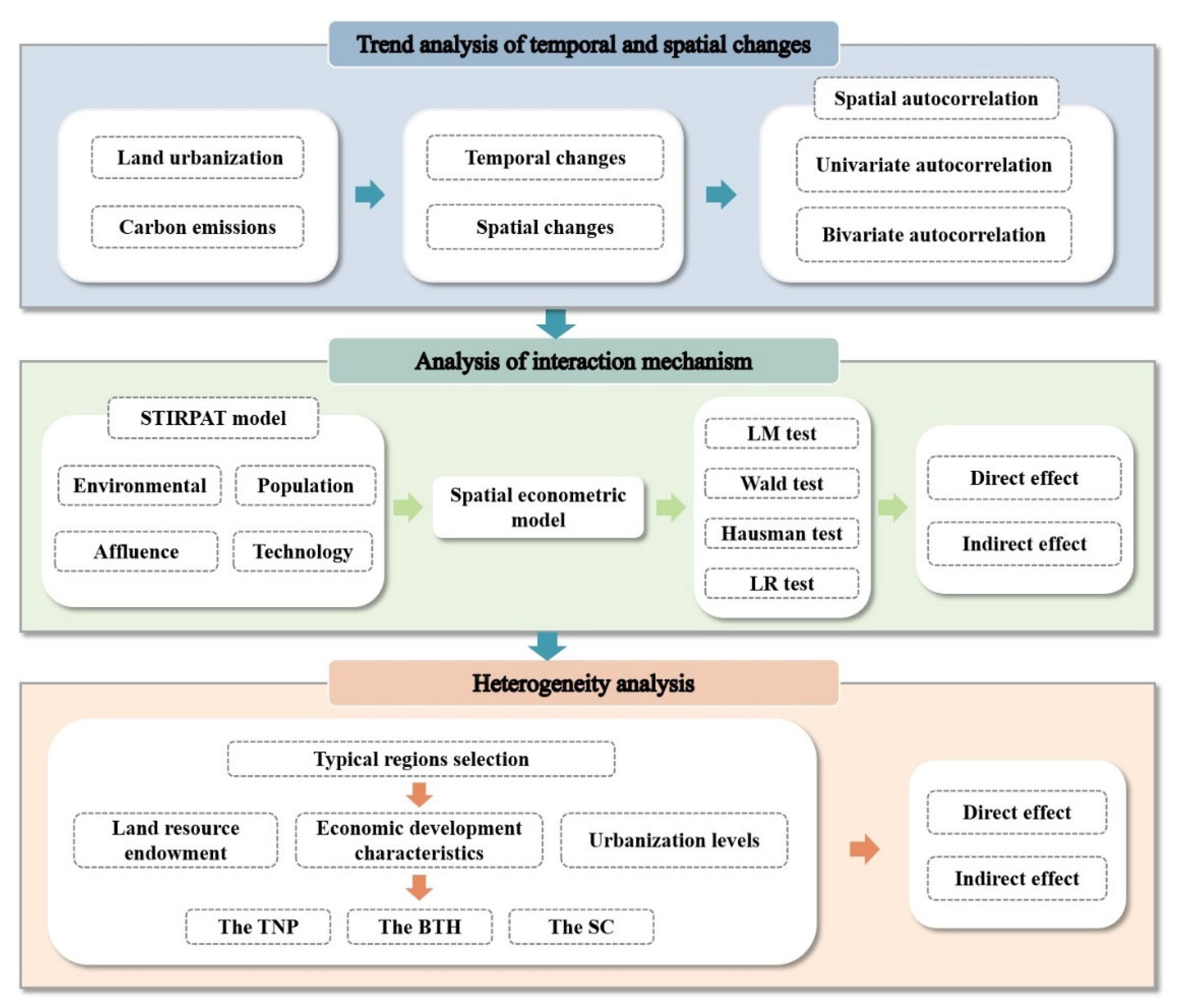

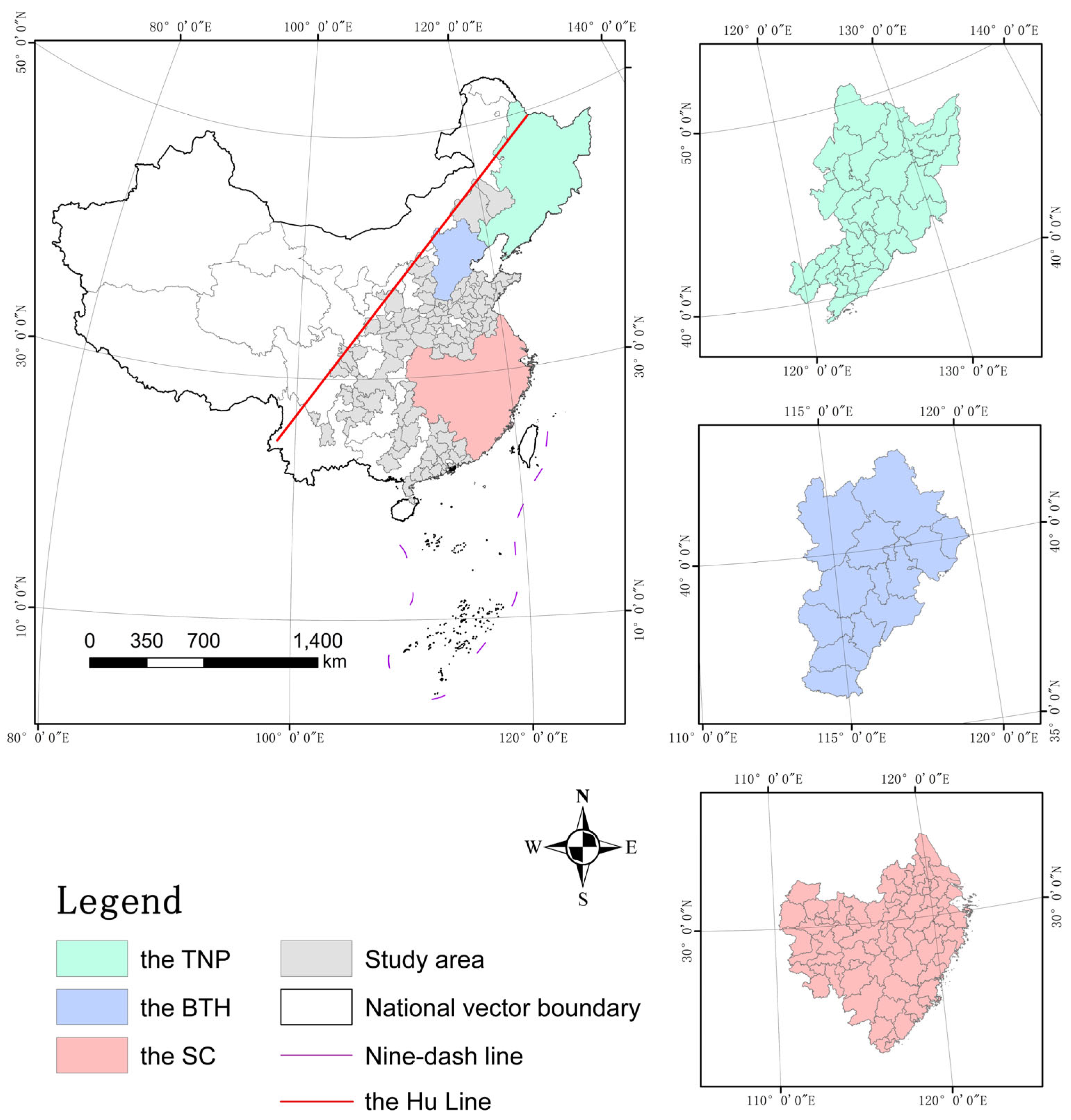


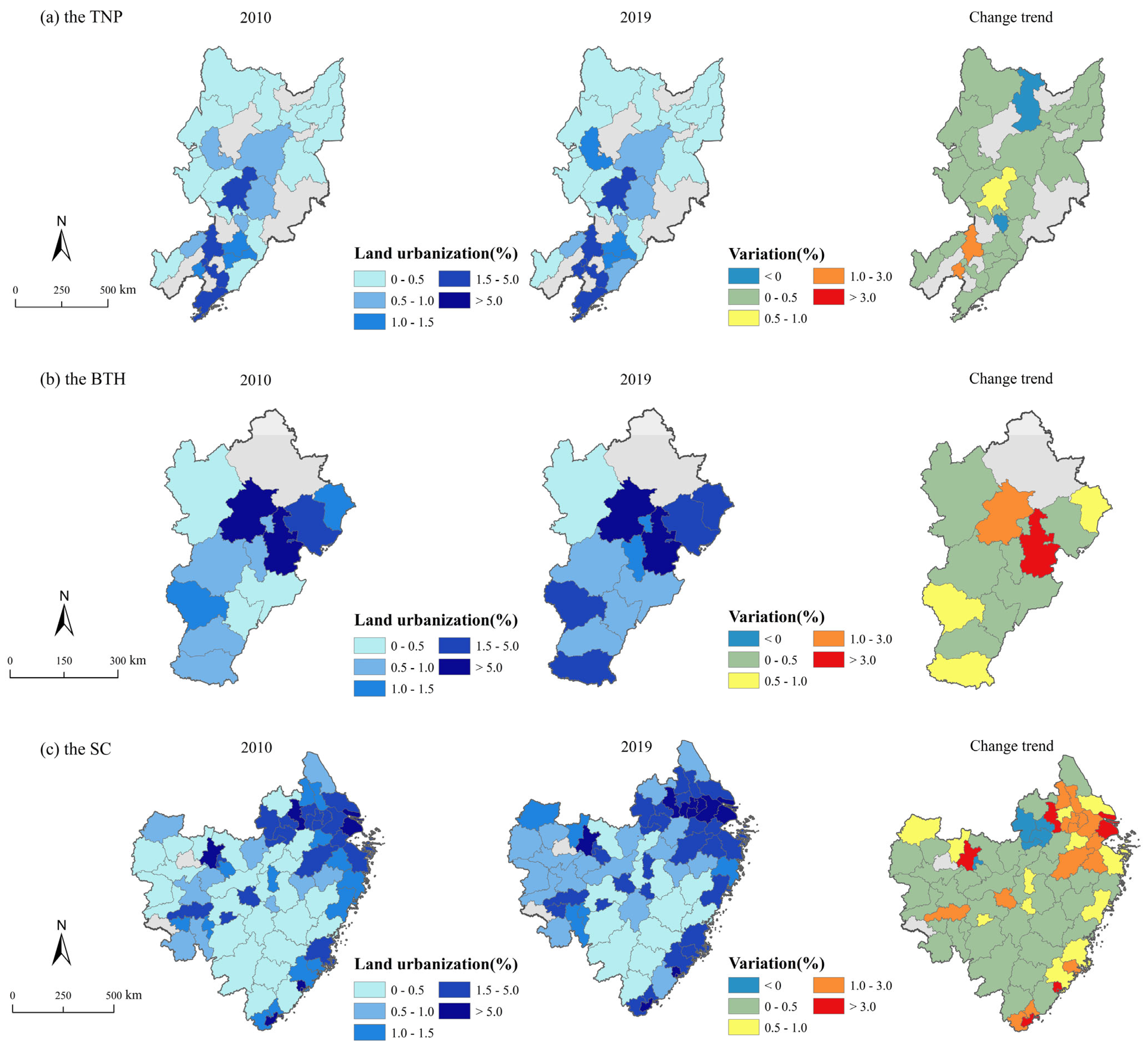



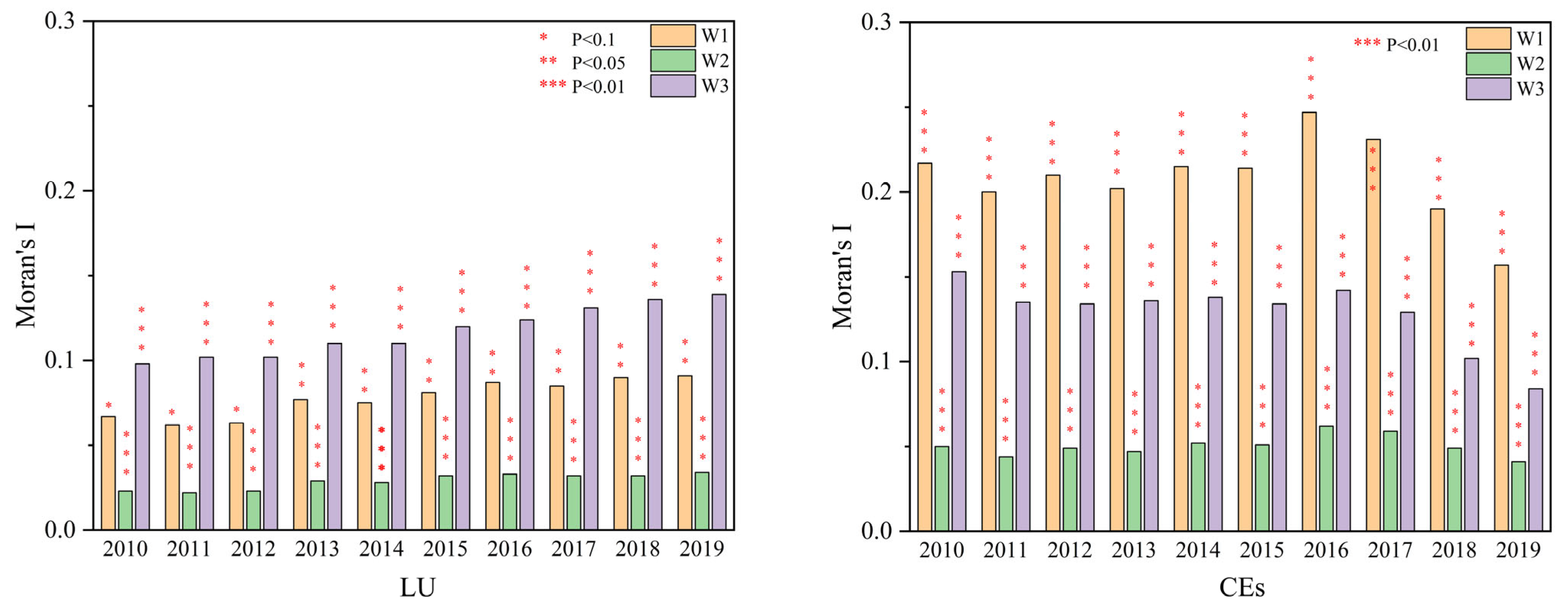


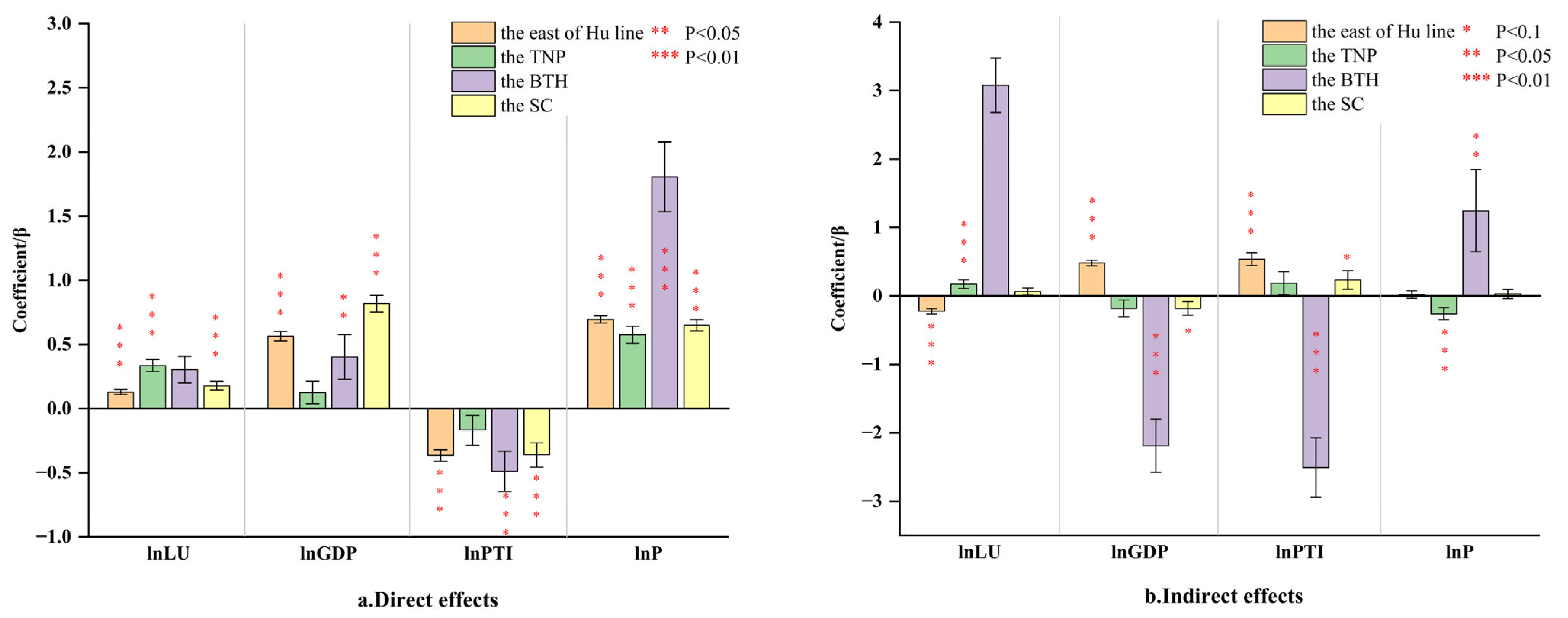
| Test | Model I W1 | Model II W2 | Model III W3 |
|---|---|---|---|
| LMERR | 263.542 *** | 476.003 *** | 3.602 * |
| R-LMERR | 269.065 *** | 490.022 *** | 0.010 |
| LMLAG | 4.706 ** | 1.848 | 38.396 *** |
| R-LMLAG | 10.230 *** | 15.867 *** | 34.804 *** |
| Wald ERR | 45.18 *** | ||
| Wald LAG | 43.48 *** | ||
| LR ERR | 44.88 *** | ||
| LR LAG | 43.02 *** | ||
| Hausman | 28.47 *** | 24.38 *** | 33.58 *** |
| LR ind | 56.82 | 41.33 | 29.12 |
| LR time | 4754.86 *** | 4809.46 *** | 4956.33 *** |
| Variable | Model I W1 | Model II W2 | Model III W3 |
|---|---|---|---|
| lnLU | 0.145 *** | 0.070 *** | 0.059 *** |
| (0.019) | (0.018) | (0.018) | |
| lnGDP | 0.535 *** | 0.725 *** | 0.681 *** |
| (0.041) | (0.041) | (0.045) | |
| lnPTI | −0.405 *** | −0.216 *** | −0.168 *** |
| (0.043) | (0.039) | (0.040) | |
| lnP | 0.692 *** | 0.609 *** | 0.594 *** |
| (0.025) | (0.024) | (0.025) | |
| W_ lnLU | −0.203 *** | ||
| (0.024) | |||
| W_ lnGDP | 0.123 *** | ||
| (0.024) | |||
| W_ lnPTI | 0.516 *** | ||
| (0.071) | |||
| W_ lnP | −0.239 *** | ||
| (0.041) | |||
| ρ | 0.372 *** | 0.090 ** | |
| (0.026) | (0.040) | ||
| λ | 0.896 *** | ||
| (0.032) | |||
| Sigma2_e | 0.384 *** | 0.408 *** | 0.451 *** |
| (0.012) | (0.013) | (0.014) |
| Variable | Model I W1 | ||
|---|---|---|---|
| Direct Effect | Indirect Effect | Total Effect | |
| lnLU | 0.129 *** | −0.224 *** | −0.095 ** |
| (0.019) | (0.039) | (0.043) | |
| lnGDP | 0.564 *** | 0.480 *** | 1.045 *** |
| (0.038) | (0.042) | (0.060) | |
| lnPTI | −0.365 *** | 0.538 *** | 0.173 * |
| (0.043) | (0.093) | (0.097) | |
| lnP | 0.695 *** | 0.022 | 0.717 *** |
| (0.028) | (0.055) | (0.066) | |
Disclaimer/Publisher’s Note: The statements, opinions and data contained in all publications are solely those of the individual author(s) and contributor(s) and not of MDPI and/or the editor(s). MDPI and/or the editor(s) disclaim responsibility for any injury to people or property resulting from any ideas, methods, instructions or products referred to in the content. |
© 2025 by the authors. Licensee MDPI, Basel, Switzerland. This article is an open access article distributed under the terms and conditions of the Creative Commons Attribution (CC BY) license (https://creativecommons.org/licenses/by/4.0/).
Share and Cite
Gu, H.; Chen, X.; Sun, H.; Huan, C.; Wang, B. How Does Land Urbanization Affect Carbon Emissions in China? Evidence from 209 Cities and Three Heterogeneous Regions in the East of the Hu Line of China. Land 2025, 14, 910. https://doi.org/10.3390/land14040910
Gu H, Chen X, Sun H, Huan C, Wang B. How Does Land Urbanization Affect Carbon Emissions in China? Evidence from 209 Cities and Three Heterogeneous Regions in the East of the Hu Line of China. Land. 2025; 14(4):910. https://doi.org/10.3390/land14040910
Chicago/Turabian StyleGu, Hanlong, Xueting Chen, Haohang Sun, Chongyang Huan, and Bingyi Wang. 2025. "How Does Land Urbanization Affect Carbon Emissions in China? Evidence from 209 Cities and Three Heterogeneous Regions in the East of the Hu Line of China" Land 14, no. 4: 910. https://doi.org/10.3390/land14040910
APA StyleGu, H., Chen, X., Sun, H., Huan, C., & Wang, B. (2025). How Does Land Urbanization Affect Carbon Emissions in China? Evidence from 209 Cities and Three Heterogeneous Regions in the East of the Hu Line of China. Land, 14(4), 910. https://doi.org/10.3390/land14040910







